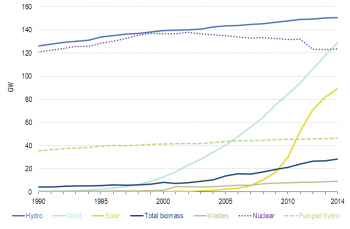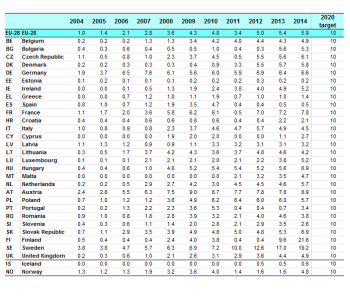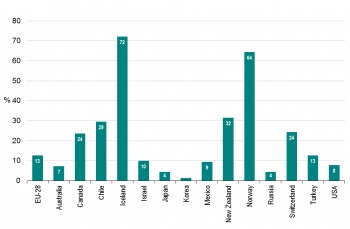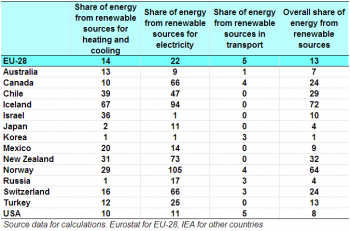Archive:Energy from renewable sources
- Data extracted in February 2016. Most recent data: Further Eurostat information, Main tables and Database. Planned article update: April 2017.
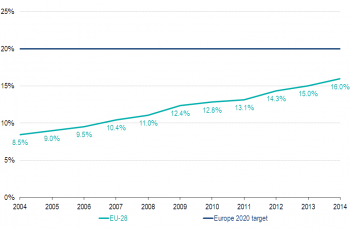
Source: Eurostat (nrg_ind_335a)
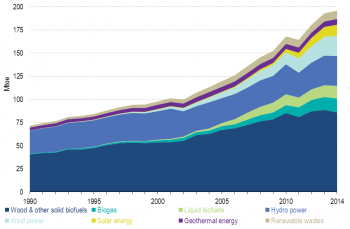
Source: Eurostat (nrg_110a)

Source: Eurostat (nrg_105a)
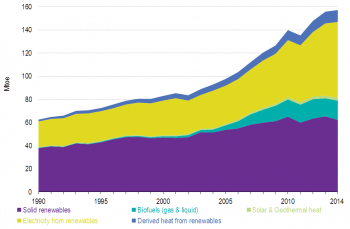
Source: Eurostat (nrg_105a) (nrg_106a) (nrg_110a)
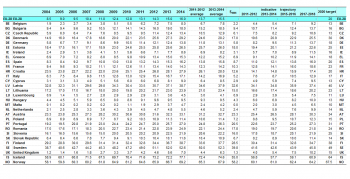
Source: Eurostat (nrg_ind_335a)
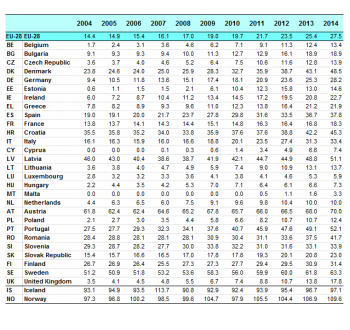
Source: Eurostat (nrg_ind_335a)
This article presents a detailed statistical overview of the production and consumption of energy from renewable sources in the European Union (EU). It is based on data compiled in accordance with accounting rules set down in the Directive 2009/28/EC on the promotion of the use of energy from renewable sources. The statistical information presented in this article is coherent with statistical information reported under Regulation (EC) No 1099/2008 on energy statistics.
Renewable energy in the EU has grown strongly in recent years. This has been prompted by the legally binding targets for renewable energy enacted by Directive 2009/28/EC. While the EU as a whole is on course to meet its 2020 targets, some Member States will need to make additional efforts to meet their obligations for the share of energy from renewable sources in the gross final consumption of energy.
Main statistical findings
After a period up to 2010 during which renewables were growing strongly, the combined effect of warm weather, slower progress by Member States in implementing the Renewable Energy Directive and Europe’s faltering economic situation led to a decrease in the use of renewable energy in 2011. However, the share of renewable sources in gross final consumption of energy did increase, since the consumption of fossil fuel energy fell more than that of renewables. Afterwards, the share of energy from renewable sources in gross final consumption of energy continued the increasing trend and by 2014 it reached 16.0 % .
Primary production of energy from renewable sources
Primary production of renewable energies is on a long-term increasing trend. Between 1990 and 2014 it increased by 174 % (an average annual growth rate of 4.3 %). However, in 2011, the primary production of renewables declined by 2.2 %; this was mainly due to the annual variation in hydropower production and decrease in the combustion of solid biomass. This was only the second decrease recorded since 1990 — the first in 2002 (-1.6 %) was also a consequence of hydropower variation. The Renewable Energy Directive requires that — for accounting purposes — hydropower and wind power production is normalised[1] for annual variations. Primary production of renewable energies is shown in Figure 2 (N.B. the figures shown for electricity production are not normalised).
In 2014, the primary production of renewables increased by 1.6 % compared with 2013. In fact, with the exception of years 2002 and 2011 (when primary production of renewables decreased) this is the lowest annual increase in the last 15 years. When compared to the primary production 5 years ago, it is now 29 % higher.
Electricity generation from renewable sources
In 2014, gross electricity generation from renewables increased by 4.9 % compared with 2013. However, the picture varies depending on the energy source: from an increase of 0.9 % for electricity generation from hydro to a 14.1 % increase for solar power. Between 1990 and 2014, total electricity generation from renewables increased by 191 %. In 2014, renewable electricity generation accounted for 28 % of total gross electricity generation[2].
Hydropower plants generate by far the largest share of electricity from renewable energy sources. Electricity generation from hydropower increased by 29 % between 1990 and 2014, even if its share of total renewable electricity generation shrank from 94 % to 42 % over the same period. This is due to the more rapid expansion of electricity generation from other renewable sources. Wind power generation more than tripled over the period 2005-2014: since 2000, it has been the second largest contributor to renewable electricity, replacing wood and other solid biomass, which had held that position since 1990. Solar power electricity generation has increased rapidly in recent years and in 2014 accounted for 11 % of all renewable electricity. Also, in 2013 the electricity generated from solar energy surpassed wood and other solid biomass and is now the third most important contributor to the electricity production from renewable sources. Solid renewables (wood and other solid biomass, excluding renewable wastes) are also used in conventional thermal generation power plants: their share in electricity from renewable sources grew from 3.5 % in 1990 to 10 % in 2014. Bioliquids and biogas, which were negligible in 1990, reached 7 % in 2013. Electricity generation from renewable sources is shown in Figure 3 (in this Figure electricity production is not normalised in the area chart but the dashed line shows the total normalised electricity generation).
Installed capacity for renewable electricity generation
The available capacity of renewable electricity generation has increased significantly over the last 20 years. Wind power capacity had already begun to increase rapidly in the late 1990s and from 2005 there was a boom in solar generation capacity. Additional capacity increases for other renewables were much more modest than for these two. Solar and wind generation are intermittent energy sources: their utilisation rate is much lower than for those renewables used in conventional thermal power stations (as well as compared with fossil fuels and nuclear power). Pumped-storage hydropower plants can be reliably used to deal with surplus electricity generation from intermittent sources. The capacity of pumped-storage hydropower plants did not increase at the same rate as solar and wind. Installed capacity for renewable sources, nuclear power and pumped-storage hydropower is shown in Figure 4. To put into perspective electricity generation capacities from renewable sources, which in 2014 was in total around 400 GW, the existing electricity generation capacity of fossil fuel plants in the EU was around 450 GW in 2014.
Production of liquid biofuels in the EU
Production of liquid biofuels increased significantly from almost nothing in 1990. There were rapid increases — especially after 2002 — producing an average annual growth rate between 2000 and 2010 of 32 %. However, production decreased in 2011 by 10 % compared with 2010. Since then it is increasing at around 10% each year. Production of liquid biofuels is shown in Figure 5.
Imports and exports of renewables
Imports and exports of renewable energy products are very difficult to analyse. It is even more difficult to provide figures corresponding to import dependency that would be comparable with fossil fuels (coal, crude oil, natural gas). The major obstacle for detailed import/export analysis is that primary feedstocks for solid, liquid and gaseous biofuels often compete for other non-energy uses. For example, wood can be used as material for furniture production and as building material on construction sites. Energy statistics track only quantities of renewable products for energy purposes; stocks of renewable products for non-energy purposes are not part of energy balances.
Another complication arises because of missing data on feedstock input for the transformation sector — for example, the raw materials for production of biofuels. These data on feedstock input are out of the scope of energy statistics. Energy balances place solid, liquid and gaseous biofuels produced in the EU in the category of ‘primary production’; this is in contrast to production of fossil-based secondary fuels, which are categorised as ‘transformation output’ (for example, the ‘primary production’ of motor gasoline or automotive diesel is zero in EU energy balance sheets).
Trade in liquid biofuels that can be blended with — or used as a substitute for — gasoline or diesel (for example, ethanol in E85 for use in flex-fuel vehicles) serves as an illustration. Trade volumes of liquid biofuels (blended part within mineral fuel plus pure biofuels) shipped between EU Member States, and internationally, are increasing. In 2012, EU-28 net imports of liquid biofuels accounted for 20 % of their gross inland consumption. For their part, net imports of biodiesel and biogasoline stood at 15 % and 30 % of gross inland consumption, respectively. (These figures include the blended part within mineral fuels and all pure biofuels.) However, in 2014 the net imports of liquid biofuels accounted only for 9 % of their gross inland consumption.
Detail data for trade in liquid biofuels are available in energy database: (nrg_126a) and (nrg_136a).
Gross inland consumption of renewables
Gross inland consumption of renewables is closely related to primary production of renewables. The only noticeable variation is due to imports and exports: primarily because of net imports of liquid biofuels, gross inland consumption of all renewables is 3 % higher than primary production. Gross inland consumption of renewables increased by 1.7 % in 2014 compared with 2013. Wood and other solid biomass continues to be the largest contributor to the mix of renewable energy sources. Hydropower and wood accounted for 91 % in 1990. However, the rate of increase since then has been much slower than for other sources notwithstanding that wood more than doubled by 2010. Consequently, their combined share decreased to 61 % in 2014. Gross inland consumption of renewable energies is shown in Figure 6 (electricity production is not normalised).
Renewable energy available for final consumption
Renewable energy available for final consumption (Figure 7) tends to rise and fall in line with changes in gross inland energy consumption from renewable sources. Rapid expansion of certain technologies caused the share of energy from solid renewables (including wood and renewable waste) to decrease from 61 % in 1990 to 40 % in 2014. However, in absolute terms it increased by 64 % during this period. Renewable energy available for final consumption increased by 69 % between 2004 and 2014. In 2014 the renewable energy available for final consumption decreased by 1 % compared to 2013.
In the EU-28, the share of energy from renewable sources in gross final consumption of energy increased from 8.5 % in 2004 to 16.0 % in 2014. This is evidence of a progress towards the Europe 2020 target of 20 %. As some countries have not yet fully implemented all provisions of the Renewable Energy Directive, some biofuels and bioliquids are not counted as compliant (sustainable) in the period 2011-2014. Some countries have also not yet improved their national statistical system to fully account for all renewable energy sources (for example for the renewable energy with respect to heat pumps). The increased share between 2010 and 2011 is not due to increased use of renewables but rather because of a decline in the use of fossil energies (oil products and natural gas). Allowing for the 2020 targets of the Energy Efficiency Directive (2012/27/EU), further decreases in the EU’s energy consumption could be expected up to 2020.
The latest data for 2005 shows a small variation with respect to data available during the preparation and adoption of the Directive in 2007-2008. Changes are due to revisions in data sets transmitted by Member States in response to annual energy questionnaires. Comparing the average of 2011-12 to the indicative trajectory set out in the Renewable Energy Directive, it can be seen that France and the Netherlands were below the first indicative trajectory values, while all other countries were above. Comparing the average of 2013-14 to the indicative trajectory set out in the Renewable Energy Directive, it can be seen that the Netherlands was below the second indicative trajectory values, while all other countries were above.
Table 1 presents data for all Member States and also the values of the indicative trajectory.
The renewable share in Estonia has been above the 2020 target value since 2011. Bulgaria and Sweden have been reaching their 2020 levels since 2012. In 2014, also the Czech Republic, Italy, Lithuania, Romania and Finland were above their 2020 target. Due to revision of data for biomass consumption in the residential sector, the updated data for Croatia indicates that its consumption of energy from renewable sources is above its 2020 target since 2004 (the first year for which values are available).
In 2014 the highest share amongst the EU-28 Member States was observed in Sweden (52.6 %) and the lowest in Luxembourg (4.5 %).
In 2014, electricity generation from renewable sources, with necessary adjustments for wind power and hydro power, contributed 27.5 % to total EU-28 electricity consumption. There is a huge variation between EU Member States - please see the detailed presentation of the share of electricity from renewable sources in gross electricity consumption in Table 2.
In 2014, renewable energy accounted for 17.7 % of total energy use for heating and cooling in the EU-28. This is a significant increase from 10.2 % in 2004. Increases in industrial sectors, services and residential use (building sector) contributed to this growth. Aerothermal, geothermal and hydrothermal heat energy captured by heat pumps is taken into account, to the extent reported by Member States. The share of energy from renewable sources in heating and cooling is presented in Table 3.
For all countries, there is a common 2020 target of 10 % for the share of renewable energy in the transport sector. The Renewable Energy Directive 2009/28/EC stipulates that only biofuels and bioliquids that fulfil sustainability criteria should be included. In some countries consumption of biofuels and bioliquids in the period 2011-2014 were not certified as compliant (sustainable) due to late implementation of Directive 2009/28/EC. While the share of renewable energy as a whole is increasing since 2004, between 2010 and 2011 its share in transport decreased. This can be attributed in part to the total absence of compliant biofuels reported by several EU countries (countries did report some biofuel use, but none or very little of it compliant in 2011). Respecting accounting rules of Directive 2009/28/EC, the share of energy from renewable sources in transport increased from 1% in 2004 to 6% in 2014. The share of energy from renewable sources in transport is presented in Table 4.
Energy data collection is harmonised on an international level in the joint OECD/IEA — European Commission/Eurostat — UNECE questionnaires. This enables some comparison of the share of energy from renewable sources between EU Member States and OECD/IEA countries. However, as not all information is available, certain additional assumptions are made in this comparison: all biofuels and bioliquids are counted towards the renewable share and without using multipliers; heat pumps are not counted: all pumped hydropower is assumed to be pure pumped hydropower and mixed hydropower is assumed to be zero; electricity in road transport is counted without any multiplier. This facilitates a harmonised comparison of the EU-28 aggregate with other OECD countries; however, in this comparison, EU-28 values are not equivalent to the values presented earlier in this article. The 2011 comparison of the EU-28 with other OECD countries and Russia is presented in Table 5 and Figure 8.
Data sources and availability
Data from the energy balance sheets have been used for all calculations. The most recent data available are for the reference year 2014 (for the purposes of comparing the EU-28 with other third countries 2011 data have been used). Data are available for all EU Member States, as well as European Economic Area countries Iceland and Norway. In general, data are complete, recent and reliably comparable across countries. This results in a high degree of accuracy and accountability of EU aggregate figures.
Methodology
All calculations reflect the version of Directive 2009/28/EC as in effect before 5 October 2015. In other words, the amendment published in the Official Journal of the European Union on 15 September 2015 (Directive (EU) 2015/1513 of the European Parliament and of the Council of 9 September 2015 amending Directive 98/70/EC relating to the quality of petrol and diesel fuels and amending Directive 2009/28/EC on the promotion of the use of energy from renewable sources) is not taken into account in the calculation approach and results presented here.
Gross inland energy consumption represents the total quantity of energy resources used for all purposes.
Energy available for final consumption represents the total quantity of energy resources available to consumers (private, commercial and industrial). It excludes energy used in transformation processes (for example electricity power plants, fuel refineries, blast furnaces). It also includes energy products that might be used for non-energy purposes (for example in chemical processes).
Gross final consumption of energy is defined in the Renewable Energy Directive 2009/28/EC as the energy commodities delivered for energy purposes to industry, transport, households, services (including public services), agriculture, forestry and fisheries, including the consumption of electricity and heat by the energy branch for electricity and heat production and including losses of electricity and heat in distribution and transmission.
Energy production from non-renewable municipal wastes was deducted from the contribution of biomass to heating and electricity generation. Consumption for pipeline transport was included in gross final consumption of energy, in line with the sectoral classification of the Energy Statistics Regulation. To improve accuracy and consistency with national statistics in calculating renewable energy shares, national calorific values were used, where available, for converting quantities of all energy products into energy units, instead of the default calorific values.
The Commission has only recently established definitive guidelines for accounting of energy from heat pumps. Despite the lack of an approved statistical methodology at the time of data collection and for reasons of completeness, the contribution of renewable energy from heat pumps was taken into account in cases where sufficient information was submitted by Member States. For these reasons, some small differences exist between data used for this publication and those published in the energy balances.
Energy statistics and energy balances available from Eurostat (as well as at international level from OECD/IEA) do not distinguish between sustainable and non-sustainable renewable sources of energy. This split is possible in the accounting tool (SHARES tool[3]) developed by Eurostat, where reporting countries have to provide additional information in this respect. It should be borne in mind, therefore — unless explicitly stated — that renewables include all renewable energy sources, both those meeting sustainability criteria and those that do not comply with such criteria.
Data for the period 2004-2010: Directive 2009/28/EC did not yet exist or was only very recently adopted. In most European countries, it had not been enacted into national legislation. The values in these years are not used for any measurement of legislative compliance with the indicative trajectory defined in part B of Annex I of the Directive. It was decided that for the years 2004-2010 all biofuels and bioliquids would be counted towards the numerator of the share of energy from renewable sources.
Data for 2011 onwards: Compliance with Article 17 (Sustainability criteria for biofuels and bioliquids) has to be assessed with respect to Article 18 (Verification of compliance with the sustainability criteria for biofuels and bioliquids). As of reference year 2011, countries are to report as compliant only those biofuels and bioliquids for which compliance with both Article 17 and Article 18 can be fully demonstrated. Only reported compliant biofuels and bioliquids are counted towards the respective shares of renewables.
As stipulated in the Renewable Energy Directive 2009/28/EC, gross final consumption of electricity from renewable sources is the electricity produced from renewable energy sources, excluding hydropower electricity produced from pumped storage plants using water previously pumped uphill. The Directive also requires electricity production from hydropower and wind energy to be normalised. Given the 15-year normalisation requirement for hydropower production and the availability of energy statistics (for the EU-28, starting from 1990), long time series of this indicator are not available.
For the purpose of calculating the share of renewable energy in heating and cooling, final consumption of energy from renewable sources is defined as the final consumption of renewable energy in industry, households, services, agriculture, forestry and fisheries for heating and cooling purposes, plus district heating produced from renewables. The total final consumption for heating and cooling is the final consumption of all energy commodities, except electricity, for purposes other than transport, plus the consumption of heat for own use at electricity and heat plants and heat losses in networks. For more detailed definition, please see SHARES tool manual.
Context
Directive 2009/28/EC on the promotion of the use of energy from renewable sources established a European framework for the promotion of renewable energy, setting mandatory national renewable energy targets for achieving a 20 % share of renewable energy in final energy consumption — and a 10 % share of energy from renewable sources in transport — by 2020. These goals are headline targets of the European 2020 strategy for growth. They contribute to Europe’s industrial innovation and technological leadership, reduce greenhouse gas emissions, improve the security of our energy supply and reduce our energy import dependency.
See also
Further Eurostat information
Publications
- Energy balance sheets 2013 data (2015 edition)
- Energy balance sheets 2011-2012 (2014 edition)
- Energy, transport and environment indicators (2014 edition)
- Renewable energy (Statistics in focus 2012)
- Renewable energy statistics (Statistics in focus 2010)
- Renewable energy indicators (Data in focus 2010)
- Renewable energy statistics (Data in focus 2007)
Main tables
- Energy (t_nrg), see:
- Energy statistics - main indicators (t_nrg_indic)
- Energy statistics - quantities (t_nrg_quant)
Database
- Energy (nrg), see:
- Energy statistics - indicators and other data (nrg_indic)
Dedicated section
Methodology / Metadata
- Energy statistics - supply, transformation and consumption (ESMS metadata file — nrg_10_esms)
- Share of energy from renewable sources (ESMS metadata file — nrg_ind_335a_esms)
Source data for tables, figures and maps (MS Excel)
Other information
- Directive 2009/28/EC on the promotion of the use of energy from renewable sources
- Regulation (EC) No 1099/2008 on energy statistics
- Renewable energy progress report 2015
- Renewable energy progress report 2013
- Renewable Energy: a major player in the European energy market
External links
- European Commission - Energy - Renewable energy
- Concerted Action on the Renewable Energy Sources Directive
- EurObserv'ER
- International Energy Agency - Renewables
- International Renewable Energy Agency
Notes
- ↑ In calculating the contribution of hydropower and wind power the effects of weather variation is smoothed through the use of data for several years. Please see Annex II of Directive 2009/28/EC for the applied rules.
- ↑ Please see (nrg_105a) for detailed data on electricity generation.
- ↑ http://ec.europa.eu/eurostat/web/energy/data/shares
